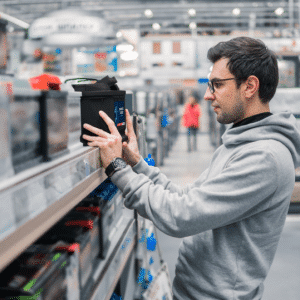Battery changing can be tedious and time-consuming, and it also requires a dedicated battery room, taking away from valuable warehouse space. Opportunity and fast charging systems provide a more efficient option to traditional battery changing, increasing productivity and eliminating the need for a dedicated battery room.
How to accommodate charging stations
With opportunity and fast charging, convenience and efficiency are the primary goals. Operators plug in their equipment during breaks or lunchtime, at a shift change, or any time they have 10 to 15 minutes of downtime. Because batteries are being charged often, one battery can work through multiple shifts.
Battery chargers can be spread out in a facility for quick, easy access. Organizations often create a parking area near the break room, making it convenient for operators to charge equipment during breaks.
Another way to increase ease of access to charging stations is to install them in the center of a parking area. This configuration allows forklifts to be parked on both sides for even greater access. If space is a concern, chargers can also be placed between dock doors or in between pallet racks.
Outlining the differences between systems
Opportunity chargers offer a 20 to 30 percent start rate and feature wireless communication between the battery and charger. Because opportunity chargers are wireless, they do not have aux pins, and so do not require modifications to batteries or lift trucks in terms of additional SBX or Euro connectors. As a result, operators can still use SB connectors, which most trucks utilize. They simply disconnect the battery from the truck and plug in, with no need for an adapter harness. However, the lack of aux pins can lead to arcing during hot disconnects, and opportunity systems may not be able to keep up with a company’s growth. These systems are best for light to medium demand applications in environments with 1.5 shifts.
Fast chargers offer a 30 to 40 percent start rate, and they feature aux pins to prevent arcing. These systems can keep up with two- to three-shift applications with medium to high demand. Fast chargers may require vented trays and external fan packs to dissipate heat, and the initial investment can be higher with fast charging systems. Aux pins may become a failure point over time, due to repeated connecting and disconnecting involved with charging. SBX or Euro connectors and battery harnesses may be needed, increasing the cost and complexity of the charging system.
For both types of charging systems, the temperature of the batteries must be monitored. Perhaps the most important concern with both systems is the need to maintain a one-to-one ratio, meaning one battery and one charger per forklift.
Choosing the right system for your operation
In order to select the right solution for your application, Stryten will perform a power study to determine your energy usage. That data will be used to create a model that will identify the best options for your current needs while planning for future growth.
Opportunity and fast charging systems are excellent solutions for organizations looking to move away from battery changing while making it easier for operators to charge their equipment during their busy shifts.







